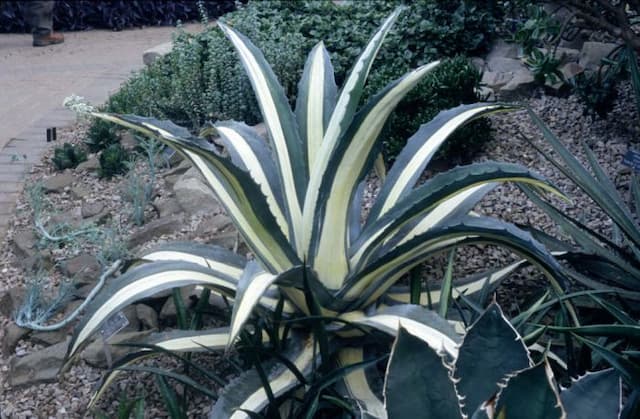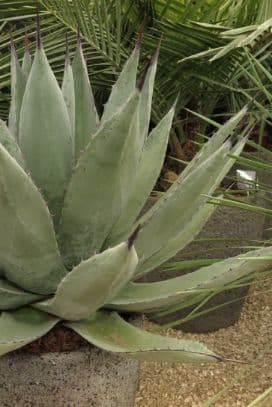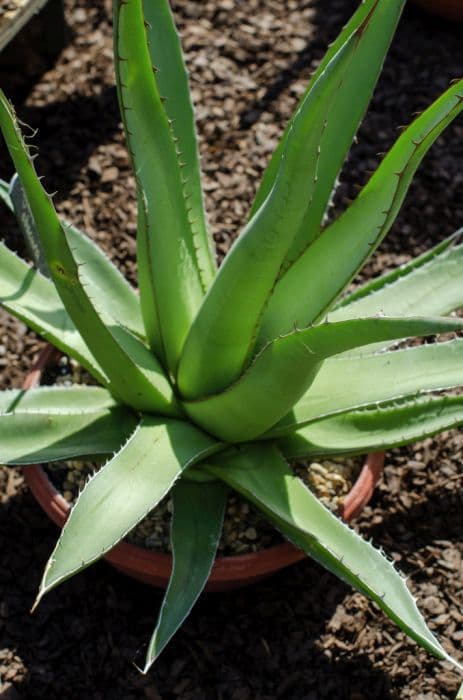Hosta Hosta 'Love Pat'

ABOUT
Hosta 'Love Pat' is a striking perennial known for its ornamental foliage. It has large, deeply veined leaves that are a unique blue-green hue, often described as having a glaucous or frosted appearance. The leaves are seer-suckered, with a puckered texture creating a tactile, almost quilted effect. They are heart-shaped to nearly round and appear to be quite thick and substantial, giving the plant a lush, robust look. During the blooming period, 'Love Pat' produces flowers that stand out against its dramatic foliage. The blooms are usually a funnel shape, typically in shades of lavender or white, and are held aloft on stems that rise above the leafy base, adding a touch of grace to the dense leaf cluster. These flower stalks can be quite striking when the plant is in bloom, providing a visual contrast and adding to the overall appeal of the plant. The flowers may attract pollinators like bees and hummingbirds, adding an element of motion and interest to the tranquil beauty of the Hosta 'Love Pat'.
About this plant
 Names
NamesFamily
Hostaceae
Synonyms
Plantain Lily, Funkia
Common names
Hosta 'Love Pat'
 Toxicity
ToxicityTo humans
Hosta 'Love Pat', commonly known as plantain lily, is not considered highly toxic to humans. However, if ingested in large quantities, it may cause mild stomach upset. In general, it is not advisable to eat any part of ornamental plants due to the potential for adverse reactions.
To pets
Plantain lily is known to be toxic to pets, particularly dogs and cats. If a pet ingests this plant, they may experience symptoms such as vomiting, diarrhea, and depression. In severe cases, the ingestion of plantain lily can lead to more serious conditions like lethargy or a loss of coordination. It is important to keep this plant out of reach of pets and to seek veterinary attention if ingestion is suspected.
 Characteristics
CharacteristicsLife cycle
Perennials
Foliage type
Deciduous
Color of leaves
Blue-green
Flower color
Lavender
Height
1-2 feet (30-60 cm)
Spread
2-3 feet (60-90 cm)
Plant type
Herb
Hardiness zones
3-8
Native area
Asia
Benefits
 General Benefits
General Benefits- Shade Tolerance: Hostas are well-known for thriving in shady areas where other plants might struggle.
- Low Maintenance: Hostas, including Love Pat, require minimal care once established, making them ideal for gardeners with limited time.
- Aesthetic Appeal: With its distinctive blue-green foliage and heavily textured leaves, Love Pat adds visual interest to the garden.
- Variety of Uses: Hostas can be used in landscape design in numerous ways, such as ground cover, border plants, or focal points.
- Drought Resistance: Though they prefer consistent moisture, established Hostas can tolerate periods of drought.
- Longevity: Hostas are perennials that can live for many years, making them a long-term addition to gardens.
- Seasonal Interest: Hostas provide a range of seasonal changes, with new growth in spring, blooms in summer, and foliage lasting into fall.
 Medical Properties
Medical PropertiesThis plant is not used for medical purposes.
 Air-purifying Qualities
Air-purifying QualitiesThis plant is not specifically known for air purifying qualities.
 Other Uses
Other Uses- Container Gardening: Hosta 'Love Pat' can be used in container gardens where their foliage color and texture can add interest to patio or balcony settings.
- Accent Plant: With its unique blue-green foliage, this hosta serves as a stunning accent plant in shade gardens.
- Backdrops for Flower Beds: Their larger leaves provide a lush backdrop for flowering plants in mixed borders.
- Erosion Control: Planted on slopes in shaded areas, hostas can help prevent soil erosion with their dense root systems.
- Ground Cover: They can be used to fill in large shaded areas where grass may struggle to grow, providing an attractive and easy-to-maintain ground cover.
- Water Garden Complement: Hostas including 'Love Pat' can be positioned around the edges of water gardens or ponds for a harmonious greenery effect.
- Leaf Castings: Leaves of the hosta can be used to create decorative leaf castings for garden art or stepping stones.
- Companion Planting: These plants are great companions to ferns, heucheras, and Astilbes, aiding in a cohesive woodland garden design.
- Texture Contrast: Utilize Hosta 'Love Pat' in a garden to provide textural contrast with plants that have fine or feathery foliage.
- Seasonal Interest: As a perennial, it offers interest throughout the growing season with its foliage, and in late summer, when it blooms with pale lavender flowers.
Interesting Facts
 Feng Shui
Feng ShuiThe Hosta is not used in Feng Shui practice.
 Zodiac Sign Compitability
Zodiac Sign CompitabilityThe Hosta is not used in astrology practice.
 Plant Symbolism
Plant Symbolism- Devotion: The name 'Love Pat' itself suggests a meaning of care and affection, symbolizing the devotion one has for another.
- Heartiness: Hostas are known for their ability to thrive in shade and their resilience, thereby representing durability and adaptability in the face of life's challenges.
- Friendship: The lush foliage and comforting presence of the hosta can symbolize the natural growth and nurturing aspect of friendships.
 Water
WaterHosta 'Love Pat', commonly known as the Love Pat Hosta, should be watered deeply once a week, ensuring that the soil is moist but not waterlogged. During hot or dry periods, increase watering to twice a week. Each watering session should consist of about 1 gallon of water per plant, allowing the water to reach the root zone without flooding the area. During the winter months, reduce watering since the plant requires less moisture when it's not actively growing. It's crucial to avoid overhead watering to prevent leaf diseases; instead, water at the base of the plant.
 Light
LightLove Pat Hostas thrive in partial to full shade, making them ideal for spots that receive morning sunlight with afternoon shade, or dappled light throughout the day. Avoid planting them in direct afternoon sun as it can scorch the foliage and compromise their vigor. These hostas are perfect for shaded areas beneath trees or on the north side of buildings, where the light conditions match their preferences.
 Temperature
TemperatureLove Pat Hostas grow best in conditions where temperatures range from 50°F to 75°F. They can endure brief periods of colder weather down to about 30°F, but they are not frost-tolerant and can be damaged by freeze. During the summer, they should be protected from extreme heat, as temperatures above 90°F can stress the plant. The ideal temperature conditions allow for healthy growth and prevent dormancy outside of the normal winter rest period.
 Pruning
PruningPrune Love Pat Hostas as needed to remove any dead or damaged leaves throughout the growing season to maintain a tidy appearance and encourage healthy growth. Early spring or after the first frost in autumn is the best time for a more thorough cleanup, cutting back the foliage to the ground if it has been damaged by frost or disease. Pruning is not typically necessary for the health of the plant, but rather for aesthetic reasons and to prevent potential disease from dead foliage.
 Cleaning
CleaningAs needed
 Soil
SoilHostas require well-draining, nutrient-rich soil with a pH between 6.5 and 7.5. A good soil mix for Hosta 'Love Pat' could include equal parts of loamy garden soil, well-rotted compost or leaf mold, and a handful of perlite or vermiculite for improved drainage.
 Repotting
RepottingHostas, including the Hosta 'Love Pat', generally need to be repotted or divided every three to five years to maintain health and vigor. Repotting is best done in the spring as the plant emerges from dormancy.
 Humidity & Misting
Humidity & MistingHosta 'Love Pat' thrives in average humidity conditions typical of outdoor environments. They do not require any special humidity considerations as they are quite adaptable to normal atmospheric humidity levels.
 Suitable locations
Suitable locationsIndoor
Place Hosta 'Love Pat' in well-lit room, away from direct sun, and water moderately.
Outdoor
Plant Hosta 'Love Pat' in partial shade, in moist, rich soil.
Hardiness zone
3-9 USDA
 Life cycle
Life cycleHosta 'Love Pat' starts its life cycle as a dormant rhizome or division planted in early spring. This is followed by sprouting, where leaves begin to emerge and unfurl to display their heavily textured, blue-green foliage. During the growing season, the plant expands and may produce tall stems with lavender or white bell-shaped flowers by midsummer. After flowering, the plant continues to grow until late summer or early fall, when it reaches maturity and the leaves reach their full size. As temperatures drop and daylight decreases in autumn, Hosta 'Love Pat' prepares for dormancy by yellowing and dying back. Throughout winter, the plant remains dormant underground until the next spring, when the cycle starts anew with new leaf growth.
 Propogation
PropogationPropogation time
Late summer
The Hosta 'Love Pat', commonly known as hosta or plantain lily, is typically propagated through division, which is best done in the spring or early fall. To propagate by division, carefully dig up the entire plant when it is not in active growth. Clean the soil from the roots and use a sharp knife or spade to cut the crown into sections, ensuring that each section has at least two or three shoots and an adequate root system. Replant the divisions immediately at the same soil depth they were originally growing, spacing them at least 12 to 24 inches (30 to 61 cm) apart to accommodate future growth. Water the new divisions well to settle the soil and reduce air pockets. This method of propagation is simple and effective, preserving the qualities of the parent plant while enabling you to expand your hosta collection or share it with fellow gardeners.









